Search
Immunoglobulin Structure and Classes
Immunoglobulins, also known as antibodies, are glycoprotein molecules produced by plasma cells or white blood cells. They specifically recognize and bind to particular antigens. This page introduces the nomenclature and criteria used to describe the structure, classes, and functional types of immunoglobulins.

Generalized structure of an immunoglobulin (IgG).
Page contents
Structure of immunoglobulins
Antibody (or immunoglobulin) molecules are glycoproteins composed of one or more units, each containing four polypeptide chains: two identical heavy chains (H) and two identical light chains (L). The amino terminal ends of the polypeptide chains show considerable variation in amino acid composition and are referred to as the variable (V) regions to distinguish them from the relatively constant (C) regions. Each L chain consists of one variable domain, VL, and one constant domain, CL. The H chains consist of a variable domain, VH, and three constant domains CH1, CH2, and CH3. Each heavy chain has about twice the number of amino acids and molecular weight (~50,000 Da) as each light chain (~25,000 Da), resulting in a total immunoglobulin monomer molecular weight of approximately 150,000 Da.
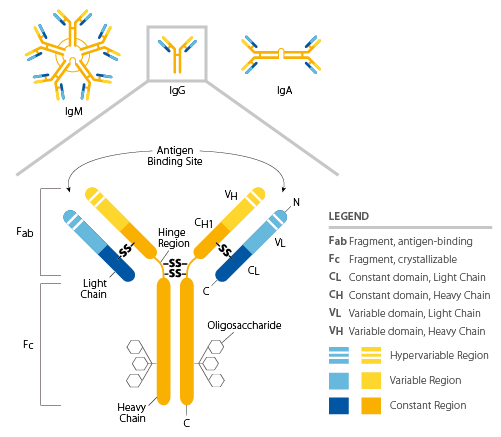
Annotated diagram of immunoglobulin structure.
Heavy and light chains are held together by a combination of non-covalent interactions and covalent interchain disulfide bonds, forming a bilaterally symmetric structure. The V regions of H and L chains comprise the antigen-binding sites of the immunoglobulin (Ig) molecules. Each Ig monomer contains two antigen-binding sites and is said to be bivalent.
The hinge region is the area of the H chains between the first and second C region domains and is held together by disulfide bonds. This flexible hinge (found in IgG, IgA, and IgD, but not IgM or IgE) region allows the distance between the two antigen-binding sites to vary.
Learn more: Antibody labeling and immobilization sites
Classes of immunoglobulins
The five primary classes of immunoglobulins are IgG, IgM, IgA, IgD, and IgE. These are distinguished by the type of heavy chain found in the molecule. IgG molecules have heavy chains known as gamma-chains; IgMs have mu-chains; IgAs have alpha-chains; IgEs have epsilon-chains; and IgDs have delta-chains.
Differences in heavy chain polypeptides allow these immunoglobulins to function in different types of immune responses and at particular stages of the immune response. The polypeptide protein sequences responsible for these differences are found primarily in the Fc fragment. While there are five different types of heavy chains, there are only two main types of light chains: kappa (κ) and lambda (λ).
Antibody classes differ in valency as a result of different numbers of Y-like units (monomers) that join to form the complete protein. For example, in humans, functioning IgM antibodies have five Y-shaped units (pentamer) containing a total of ten light chains, ten heavy chains, and ten antigen-binding.
IgG class
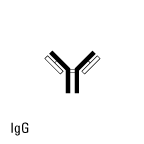
Properties of IgG:
- Molecular weight: 150,000 Da
- H-chain type (MW): gamma (53,000 Da)
- Serum concentration: 10 to 16 mg/mL
- Percent of total immunoglobulin: 75%
- Glycosylation (by weight): 3%
- Distribution: intra- and extravascular
- Function: secondary response
- Learn more about IgG
IgM class
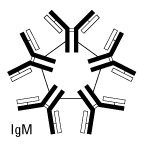
Properties of IgM:
- Molecular weight: 900,000 Da
- H-chain type (MW): mu (65,000 Da)
- Serum concentration: 0.5 to 2 mg/mL
- Percent of total immunoglobulin: 10%
- Glycosylation (by weight): 12%
- Distribution: mostly intravascular
- Function: primary response
- Learn more about IgM
IgA class
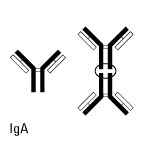
Properties of IgA:
- Molecular weight: 320,000 Da (secretory)
- H-chain type (MW): alpha (55,000 Da)
- Serum concentration: 1 to 4 mg/mL
- Percent of total immunoglobulin: 15%
- Glycosylation (by weight): 10%
- Distribution: intravascular and secretions
- Function: protect mucus membranes
- Learn more about IgA
IgD and IgE class
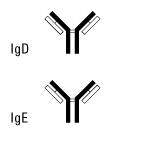
Properties of IgD:
- Molecular weight: 180,000 Da
- H-chain type (MW): delta (70,000 Da)
- Serum concentration: 0 to 0.4 mg/mL
- Percent of total immunoglobulin: 0.2%
- Glycosylation (by weight): 13%
- Distribution: lymphocyte surface
- Function: unknown
- Learn more about IgD
Properties of IgE:
- Molecular weight: 200,000 Da
- H-chain type (MW): epsilon (73,000 Da)
- Serum concentration: 10 to 400 ng/mL
- Percent of total immunoglobulin: 0.002%
- Glycosylation (by weight): 12%
- Distribution: basophils and mast cells in saliva and nasal secretions
- Function: protect against parasites
- Learn more about IgE
Explore: Isotype control antibodies
Subclasses of immunoglobulins
In addition to the major immunoglobulin classes, several Ig subclasses exist in all members of a particular animal species. Antibodies are classified into subclasses based on minor differences in the heavy chain type of each Ig class. In humans there are four subclasses of IgG: IgG1, IgG2, IgG3, and IgG4 (numbered in order of decreasing concentration in serum).
Variance among different subclasses is less than the variance among different classes. For example, IgG1 is more closely related to IgG2, IgG3 and IgG4 than to IgA, IgM, IgD, or IgE. Consequently, antibody-binding proteins (e.g., Protein A or Protein G) and most secondary antibodies used in immunodetection methods cross-react with multiple subclasses but usually not multiple classes of Ig.
Learn more: Antibody isotyping and characterization
Learn more: Antibody purification methods
Explore: Antibody purification products
Polyclonal and monoclonal antibodies
Antibodies (whatever their class or subclass) are produced and purified in two basic forms for use as reagents in immunoassays: polyclonal and monoclonal. Typically, the immunological response to an antigen is heterogeneous, resulting in many different cell lines of B lymphocytes (precursors of plasma cells) producing antibodies to the same antigen. All of these cells originate from common stem cells, yet each develops the individual capacity to make an antibody that recognizes a particular determinant (epitope) on the same antigen. As a consequence of this heterogeneous response, serum from an immunized animal will contain numerous antigen-specific antibody clones, potentially of several different immunoglobulin classes and subclasses comprising generally 2 to 5% of the total immunoglobulin. Because it contains this heterogeneous collection of antigen-binding immunoglobulins, an antibody purified from such a sample is called a polyclonal antibody. Polyclonal antibodies, which are generally purified directly from serum, are especially useful as labeled secondary antibodies in immunoassays.
Because an individual B lymphocyte produces and secretes only one specific antibody molecule, clones of B lymphocytes produce monoclonal antibodies. All antibodies secreted by a B cell clone are identical, providing a source of homogeneous antibody having a single defined specificity. However, while B lymphocytes can be isolated from suspensions of spleen or lymph node cells excised from immunized animals, they have a limited life span and cannot be cultured directly to produce antibody in useful amounts. Fortunately, this restriction has been overcome with the development of hybridoma technology, wherein isolated B lymphocytes in suspension are fused with myeloma cells from the same species (usually mouse) to create monoclonal hybrid cell lines that are virtually immortal while still retaining their antibody-producing abilities. Such hybridomas may be stored frozen and cultured as needed to produce the specific monoclonal antibody. Monoclonal antibodies are especially useful as primary antibodies in applications that require single epitope specificity and an unchanging supply over many years of use. Hybridoma clones may be grown in cell culture for collection of antibodies from ascites fluid.
Related content
References
- Alberts, B., et al. (1983). Molecular Biology of the Cell. Garland Publishing, Inc., New York, NY.
- Harlow, E. and Lane, D. (1988). Antibodies: A Laboratory Manual. Cold Spring Harbor Laboratory, Cold Spring Harbor, NY.
- Sites, D.P., et al. (1976). Basic & Clinical Immunology. Lange Medical Publication, Los Altos, CA.